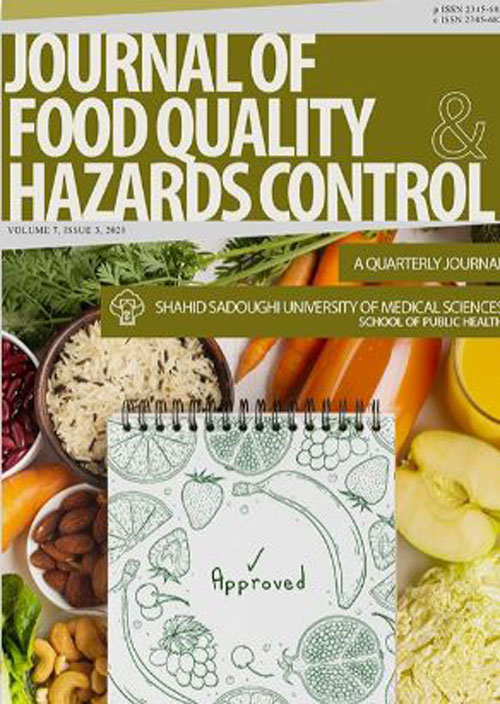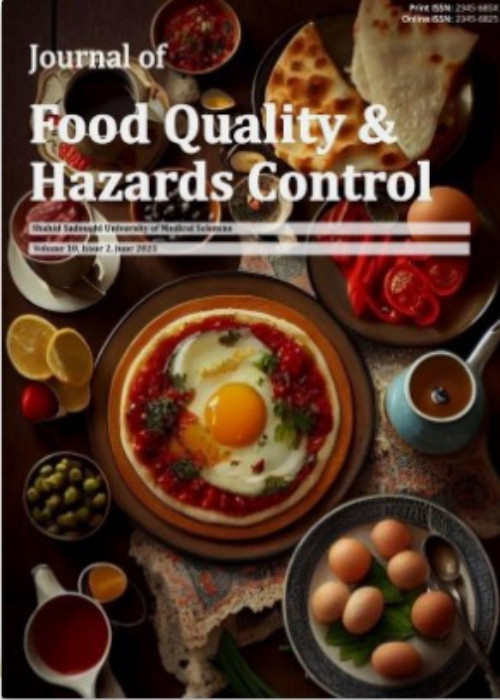فهرست مطالب

Journal of Food Quality and Hazards Control
Volume:7 Issue: 4, Dec 2020
- تاریخ انتشار: 1399/10/01
- تعداد عناوین: 8
-
-
Pages 163-169Background
Meat inspection is one of the essential tools for ensuring good quality and safe meat. The objective of this study was to evaluate carcass condemnation of cattle slaughtered in Oshana region, North of Namibia.
MethodsIn this 4-year retrospective study, causes, patterns, and economic implications of carcass condemnation of cattle slaughtered in Oshana region, North of Namibia were evaluated based on post-mortem inspection procedure. The SPSS software version 25 was used for statistical analysis.
ResultsOverall, 0.37% (120 out of 32 648) beef carcasses were condemned during the period of this study. The major causes of condemnation of carcasses were bruising (60 out of 120; 50%), followed by pus contamination. The condemnation rate in female cattle (65%) was significantly (p<0.05) higher than male cattle (35%). Overall, a significantly greater number (p<0.05) of carcasses were condemned in summer (74.2%) than in winter (25.8%).
ConclusionThis study identified bruising, pus contamination, and cachexia as the major causes of bovine carcass condemnation in North of Namibia and showed that carcass condemnation rate varied with the year, season, and age.DOI: 10.18502/jfqhc.7.4.4843
Keywords: Cattle, Abattoirs, Food Inspection, Animal Diseases, Public Health, Namibia -
Pages 170-174Background
Herbal teas are produced and sold in packaged or unpackaged forms all over the world. The aim of this study was microbial evaluation of Turkish herbal teas before and after infusion in boiled water.
MethodsA total of 20 packaged and unpackaged samples of Turkish herbal teas, including chamomile, salvia, green, mix, apple, mate, ginger, linden, fennel, and senna tea were collected. All of the samples were analyzed before and after infusion in hot water (~100 °C). Microbiological analyses were performed with tenfold serial dilution for yeast-mold, Salmonella, and Cronobacter sakazakii after enrichment by using the spread-on-plate method on selective agar. Data were statistically analyzed by using Microsoft Office Professional Plus 2013 Excel software.
ResultsThree out of the 20 tea samples (15%) were contaminated with C. sakazakii. None of the samples were contaminated with Salmonella spp. No significant difference was found in occurrence of C. sakazakii before and after infusion of the samples (p>0.05). Mold and yeast contamination were found in 12 out of 20 teas samples (60%). No statistical significance (p>0.05) was found between the mold-yeast contents of the unpackaged and packaged herbal teas. After infusion, neither mold nor yeast was observed in any of the samples.
ConclusionAll of the herbal teas in this research were found to be within the microbiological limits for consumption according to Turkish Food Codex. However, the microbiological results highlighted the need for quality control of senna tea during production to eliminate the risk of C. sakazakii contamination.DOI: 10.18502/jfqhc.7.4.4844
Keywords: Teas, Herbal, Cronobacter sakazakii, Salmonella, Fungi, Food Microbiology, Turkey -
Pages 175-180Background
Kebab is one of the popular ready-to-eat foods in Indonesia and sold as a street food. The purpose of this study was to determine occurrence and antibiotic resistance of Escherichia coli in street-vended kebab in Dramaga, Bogor, Indonesia.
MethodsTotally, 43 samples of kebab meat were collected from street food kebab vendors. Examinations on Total Plate Count (TPC), and total E. coli using Most Probable Number (MPN) method were referred to the Indonesia National Standard. The antibiotic resistance test was carried out using the Kirby-Bauer disk diffusion method.
ResultsThe mean of TPC in kebab samples was 5.3 log10 Colony Forming Unit (CFU)/g. Based on TPC, 13 out of 43 (30.2%) of kebab samples did not comply with the Indonesia National Standard with maximum acceptable level of 5 log10 CFU/g. E. coli was identified in 5 out of 43 samples (11.6%) with mean of 39.2 MPN/g ranged from 7.4 to 150 MPN/g which were higher than standard level (0.5 log10 CFU/g). Four out of 5 E. coli isolated from kebab samples were resistant to gentamycin. All E. coli isolates were susceptible to amoxicillin/clavulanate and chloramphenicol.
ConclusionThe occurrence of antibiotic resistant E. coli in ready-to-eat kebab in this area of Indonesia could cause the health problem in consumers. The local government should conduct the monitoring and surveillance on the occurrence of pathogens and the antibiotic resistance in food chain. DOI: 10.18502/jfqhc.7.4.4845
Keywords: Escherichia coli, Bacterial Load, Drug Resistance, Microbial, Meat Products, Fast Foods, Indonesia -
Pages 181-187Background
Sarcocystosis is one of the most distributed parasitic diseases over the world, caused by Sarcocystis spp. In this study, we assessed the effect of electron beam irradiation on the viability of Sarcocystis spp. in beef.
MethodsExperimental beef groups were irradiated by four different electron beam doses of 1, 2, 3, and 4 kGy, at intervals of 0 and 24 h after irradiation, then the samples were transferred inside a sterile microtube containing RNAlater solution and stored at -20 °C till next steps. RNA extractions and cDNA synthesis were done using the related kit in order to detect the presence of the 18S ribosomal RNA region. Relative quantification was carried out using SYBR Green Real time Polymerase Chain Reaction. The statistical analysis was done using SPSS 16.0 by Tukey’s and Kruskal-Wallis tests.
ResultsIrradiation at zero time was not effective on viability of Sarcocystis, but at 24 h, irradiation doses of 3 (p=0.003) and 4 kGy (p=0.008) caused a significant reduction in Sarcocystis viability. Irradiation doses of 1 and 2 kGy had no significant (p>0.05) effect on Sarcocystis viability reduction. Also, no significant differences (p>0.05) were observed between irradiation doses of 3 and 4 kGy.
ConclusionElectron beam radiation at dose of 3 kGy was effective as the optimal dose for the elimination of Sarcocystis spp. in beef. DOI: 10.18502/jfqhc.7.4.4846
Keywords: Radiation, Sarcocystis, Red Meat, Survival, Microbial Viability, Real-Time Polymerase Chain Reaction -
Pages 188-195Background
Among the bacteria that cause food poisoning, Staphylococcus aureus is one of the most common causes of food poisoning worldwide. The aim of this study was to investigate the presence of S. aureus strains in Iranian hamburgers, analysis of their antibiotic resistance pattern, and molecular detection of mecA gene in isolated strains.
MethodsA total of 100 Iranian handmade (traditional) and packaged (factory-made) hamburger samples were investigated for the existence of S. aureus. The pattern of antibiotic resistance and the presence of mecA genes were investigated by disk diffusion and molecular methods, respectively. Data were statistically analyzed by SPSS software v. 24.
ResultsThe prevalence of S. aureus isolated in handmade hamburgers was significantly (p=0.008) higher than packaged ones. Most of 39 isolated S. aureus strains were susceptible to ciprofloxacin (31 isolate), chloramphenicol (27 isolate), and trimethoprim/sulfamethoxazole (37 isolate). The highest antibiotic resistance was observed for penicillin G followed by oxacillin and tetracycline. All isolates were found susceptible to vancomycin and gentamicin. Six S. aureus isolates which were evaluated for methicillin-resistance, contained the mecA gene.
ConclusionThe high presence of the S. aureus in Iranian hamburgers and the remarkable antibiotic resistance emphasize the need for policies which enforce hygienic practices within the food industry and fast food outlets.DOI: 10.18502/jfqhc.7.4.4847
Keywords: Drug Resistance, Microbial, Methicillin-Resistant Staphylococcus aureus, Meat Products, Iran -
Pages 196-199Background
Histamine is an essential biogenic amine produced as a result of microbial decomposition of histidine during seafood processing and storage. The objective of this study was to evaluate histamine concentration in freshwater and marine fish marketed in Stara Zagora region, Bulgaria.
MethodsForty fish samples were purchased from local fish farms and retail stores in Stara Zagora, Bulgaria. Enzyme-Linked Immunosorbent Assay was used to determine histamine levels. The data were processed using GraphPad Software InStat 3.
ResultsHistamine was detected in 26 out of 40 (65%) samples, and none of them exceeded the regulatory limit of 200 mg/kg. The average histamine content in marine fish (6.965±3.187 mg/kg) was insignificantly (p>0.05) higher than that in freshwater fish (4.503±1.133 mg/kg).
ConclusionThe results reveal low levels of histamine in freshwater and marine fish indicating their good quality. However, its presence in seafoods remains a major food safety problem that requires permanent regulation of histamine concentration in fish.DOI: 10.18502/jfqhc.7.4.4848
Keywords: Fish Products, Histamine, Enzyme-Linked Immunosorbent Assay, Bulgaria -
Pages 200-204Background
Genetically Modified (GM) foods are produced using genetic engineering. This survey attempted to identify the presence of GM rice varieties among some imported rice samples in Iran.
MethodsFrom May to July 2016, a total of 50 samples of the imported rice to Iran were obtained, including 20 bulk rice samples from Bandar Abbas custom, Southern Iran and 30 retail rice samples from some commercial brands sold in the local markets of Yazd, Iran. Polymerase Chain Reaction was used to assess the GM varieties.
ResultsNone of the studied rice samples had the target genes related to GM products.
ConclusionThis study indicated no evidence for presence of GM rice among some bulk and retail imported rice samples in Iran. Since marketing of GM rice is not legally permitted in Iran, more comprehensive studies must be designed with higher sample size in various provinces of country to achieve more detailed data about situation of GM rice in the Iranian markets. DOI: 10.18502/jfqhc.7.4.4849
Keywords: Food, Genetically Modified, Oryza sativa, Polymerase Chain Reaction, Iran


